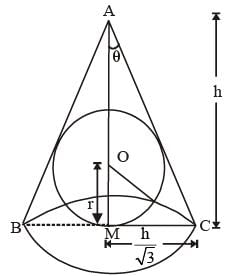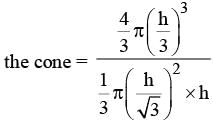CAT Exam > CAT Questions > A spherical ball of the maximum possible volu...
Start Learning for Free
A spherical ball of the maximum possible volume is placed inside a right-circular cone of height ‘h’ units. If the radius of the base of the cone is equal to h/ √3 units, then the ratio of the volume of the sphere to that of the cone is
(2013)
- a)4 : 9
- b)5 : 9
- c)1 : √3
- d)2 : 3√3
Correct answer is option 'A'. Can you explain this answer?
Verified Answer
A spherical ball of the maximum possible volume is placed inside a rig...

Let the semi vertical angle of the cone be θ.

The vertical angle of the cone = 60°
Therefore, the triangle ABC is an equilateral triangle.
Therefore, the center (O) of the circle will coincide with the centroid of the triangle ABC.
In triangle ACM, OC is angle bisector of ∠ACM.
∴ ∠OCM = 30°
In ΔOCM,

Hence, the ratio of the volume of the sphere to that of

∴ Required ratio = 4 : 9
Most Upvoted Answer
A spherical ball of the maximum possible volume is placed inside a rig...

Let the semi vertical angle of the cone be θ.

The vertical angle of the cone = 60°
Therefore, the triangle ABC is an equilateral triangle.
Therefore, the center (O) of the circle will coincide with the centroid of the triangle ABC.
In triangle ACM, OC is angle bisector of ∠ACM.
∴ ∠OCM = 30°
In ΔOCM,

Hence, the ratio of the volume of the sphere to that of

∴ Required ratio = 4 : 9
Community Answer
A spherical ball of the maximum possible volume is placed inside a rig...
Let's call the height of the cone h and the radius of the cone r. Since we want to find the maximum possible volume of the spherical ball, we need to find the maximum possible radius of the ball.
To do this, we can consider a cross-section of the cone. In the cross-section, we have a right triangle with the radius of the cone as the base and the height of the cone as the perpendicular side. The hypotenuse of this triangle represents the slant height of the cone.
Using the Pythagorean theorem, we have:
r^2 + h^2 = (slant height)^2
Since the slant height is longer than the height, we can write:
r^2 + h^2 < (slant="" />
Now, let's consider the cross-section of the ball placed inside the cone. In this cross-section, we have a right triangle with the radius of the ball as the base, the height of the ball as the perpendicular side, and the slant height of the cone as the hypotenuse.
Using the Pythagorean theorem, we have:
r^2 + h^2 = (slant height)^2
Since we want to find the maximum possible volume of the ball, we want to maximize the radius of the ball. In order to do this, we want to make the slant height of the cone as small as possible.
From the previous inequality, we know that r^2 + h^2 < (slant="" height)^2.="" therefore,="" in="" order="" to="" make="" the="" slant="" as="" small="" as="" possible,="" we="" want="" to="" make="" the="" right="" side="" of="" the="" inequality="" as="" close="" to="" r^2="" +="" h^2="" as="" />
This means that we want the slant height to be equal to r^2 + h^2. Therefore, the maximum possible volume of the ball is achieved when the slant height of the cone is equal to the radius of the ball.
In other words, the maximum possible volume of the ball is achieved when the radius of the ball is equal to the slant height of the cone.
To do this, we can consider a cross-section of the cone. In the cross-section, we have a right triangle with the radius of the cone as the base and the height of the cone as the perpendicular side. The hypotenuse of this triangle represents the slant height of the cone.
Using the Pythagorean theorem, we have:
r^2 + h^2 = (slant height)^2
Since the slant height is longer than the height, we can write:
r^2 + h^2 < (slant="" />
Now, let's consider the cross-section of the ball placed inside the cone. In this cross-section, we have a right triangle with the radius of the ball as the base, the height of the ball as the perpendicular side, and the slant height of the cone as the hypotenuse.
Using the Pythagorean theorem, we have:
r^2 + h^2 = (slant height)^2
Since we want to find the maximum possible volume of the ball, we want to maximize the radius of the ball. In order to do this, we want to make the slant height of the cone as small as possible.
From the previous inequality, we know that r^2 + h^2 < (slant="" height)^2.="" therefore,="" in="" order="" to="" make="" the="" slant="" as="" small="" as="" possible,="" we="" want="" to="" make="" the="" right="" side="" of="" the="" inequality="" as="" close="" to="" r^2="" +="" h^2="" as="" />
This means that we want the slant height to be equal to r^2 + h^2. Therefore, the maximum possible volume of the ball is achieved when the slant height of the cone is equal to the radius of the ball.
In other words, the maximum possible volume of the ball is achieved when the radius of the ball is equal to the slant height of the cone.

|
Explore Courses for CAT exam
|

|
Question Description
A spherical ball of the maximum possible volume is placed inside a right-circular cone of height ‘h’ units. If the radius of the baseof the cone is equal to h/ √3 units, then the ratio of the volume of the sphere to that of the cone is(2013)a)4 : 9b)5 : 9c)1 : √3d)2 : 3√3Correct answer is option 'A'. Can you explain this answer? for CAT 2025 is part of CAT preparation. The Question and answers have been prepared according to the CAT exam syllabus. Information about A spherical ball of the maximum possible volume is placed inside a right-circular cone of height ‘h’ units. If the radius of the baseof the cone is equal to h/ √3 units, then the ratio of the volume of the sphere to that of the cone is(2013)a)4 : 9b)5 : 9c)1 : √3d)2 : 3√3Correct answer is option 'A'. Can you explain this answer? covers all topics & solutions for CAT 2025 Exam. Find important definitions, questions, meanings, examples, exercises and tests below for A spherical ball of the maximum possible volume is placed inside a right-circular cone of height ‘h’ units. If the radius of the baseof the cone is equal to h/ √3 units, then the ratio of the volume of the sphere to that of the cone is(2013)a)4 : 9b)5 : 9c)1 : √3d)2 : 3√3Correct answer is option 'A'. Can you explain this answer?.
A spherical ball of the maximum possible volume is placed inside a right-circular cone of height ‘h’ units. If the radius of the baseof the cone is equal to h/ √3 units, then the ratio of the volume of the sphere to that of the cone is(2013)a)4 : 9b)5 : 9c)1 : √3d)2 : 3√3Correct answer is option 'A'. Can you explain this answer? for CAT 2025 is part of CAT preparation. The Question and answers have been prepared according to the CAT exam syllabus. Information about A spherical ball of the maximum possible volume is placed inside a right-circular cone of height ‘h’ units. If the radius of the baseof the cone is equal to h/ √3 units, then the ratio of the volume of the sphere to that of the cone is(2013)a)4 : 9b)5 : 9c)1 : √3d)2 : 3√3Correct answer is option 'A'. Can you explain this answer? covers all topics & solutions for CAT 2025 Exam. Find important definitions, questions, meanings, examples, exercises and tests below for A spherical ball of the maximum possible volume is placed inside a right-circular cone of height ‘h’ units. If the radius of the baseof the cone is equal to h/ √3 units, then the ratio of the volume of the sphere to that of the cone is(2013)a)4 : 9b)5 : 9c)1 : √3d)2 : 3√3Correct answer is option 'A'. Can you explain this answer?.
Solutions for A spherical ball of the maximum possible volume is placed inside a right-circular cone of height ‘h’ units. If the radius of the baseof the cone is equal to h/ √3 units, then the ratio of the volume of the sphere to that of the cone is(2013)a)4 : 9b)5 : 9c)1 : √3d)2 : 3√3Correct answer is option 'A'. Can you explain this answer? in English & in Hindi are available as part of our courses for CAT.
Download more important topics, notes, lectures and mock test series for CAT Exam by signing up for free.
Here you can find the meaning of A spherical ball of the maximum possible volume is placed inside a right-circular cone of height ‘h’ units. If the radius of the baseof the cone is equal to h/ √3 units, then the ratio of the volume of the sphere to that of the cone is(2013)a)4 : 9b)5 : 9c)1 : √3d)2 : 3√3Correct answer is option 'A'. Can you explain this answer? defined & explained in the simplest way possible. Besides giving the explanation of
A spherical ball of the maximum possible volume is placed inside a right-circular cone of height ‘h’ units. If the radius of the baseof the cone is equal to h/ √3 units, then the ratio of the volume of the sphere to that of the cone is(2013)a)4 : 9b)5 : 9c)1 : √3d)2 : 3√3Correct answer is option 'A'. Can you explain this answer?, a detailed solution for A spherical ball of the maximum possible volume is placed inside a right-circular cone of height ‘h’ units. If the radius of the baseof the cone is equal to h/ √3 units, then the ratio of the volume of the sphere to that of the cone is(2013)a)4 : 9b)5 : 9c)1 : √3d)2 : 3√3Correct answer is option 'A'. Can you explain this answer? has been provided alongside types of A spherical ball of the maximum possible volume is placed inside a right-circular cone of height ‘h’ units. If the radius of the baseof the cone is equal to h/ √3 units, then the ratio of the volume of the sphere to that of the cone is(2013)a)4 : 9b)5 : 9c)1 : √3d)2 : 3√3Correct answer is option 'A'. Can you explain this answer? theory, EduRev gives you an
ample number of questions to practice A spherical ball of the maximum possible volume is placed inside a right-circular cone of height ‘h’ units. If the radius of the baseof the cone is equal to h/ √3 units, then the ratio of the volume of the sphere to that of the cone is(2013)a)4 : 9b)5 : 9c)1 : √3d)2 : 3√3Correct answer is option 'A'. Can you explain this answer? tests, examples and also practice CAT tests.

|
Explore Courses for CAT exam
|

|
Signup for Free!
Signup to see your scores go up within 7 days! Learn & Practice with 1000+ FREE Notes, Videos & Tests.























